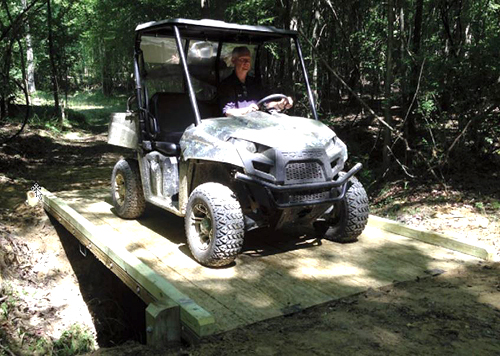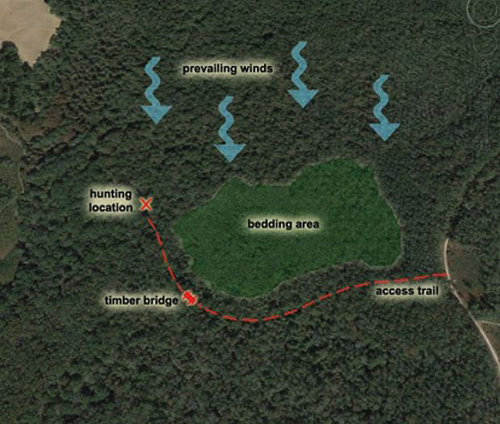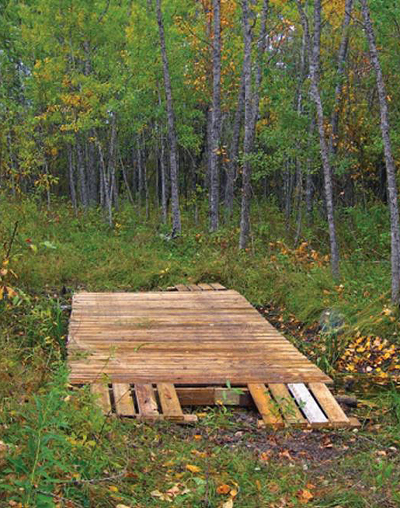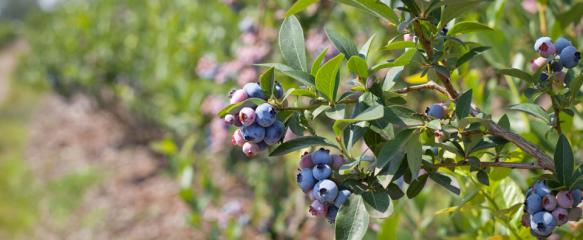Russell Holmes | Originally published in GameKeepers: Farming for Wildlife Magazine
Land and wildlife management is rapidly evolving and reaching new heights in popularity, due in part to the vast amounts of available information and the abundance of success stories. As hunters and land managers, /your-obsession/land-management we love to consume information on how to improve the properties we manage – from food plot strategies to prescribed burning to harvest criteria. But one often-overlooked aspect of an effective management plan is the importance of an efficient access system of roads, trails, and bridges. This part of the job is called bridge property management.
Bridges are a critical component because creeks, canals, swamps and ditches can make portions of a property inaccessible to people or the equipment needed to improve the habitat. How can we effectively manage a property if we can’t access large portions of it? Planting and maintaining food plots, mowing, timber stand improvement, prescribed burning – nearly all habitat improvement measures periodically require access for people and equipment. A well-planned access system must take into account several design considerations and environmental factors, and offers many advantages both, to land managers and to the game we manage.
Factors of Bridges: Land Management Considerations
There are numerous factors to consider when positioning roads and bridges on a property – and each property has its own challenges and opportunities. Topography, climate, land use, and your management goals are among the most important elements to take into consideration. After assessing your needs and defining your management goals, topography is a good place to start when designing a new access plan. You can acquire topographic data on nearly any property through a variety of digital sources or by using the U.S. Geological Survey quadrangle maps. Of course, there is still no substitute for spending time riding and walking the property. Topographic features often constrain the location of a new road, but can also offer opportunities. If the property has substantial elevation changes, try to work with the lay of the land, rather than imposing a rigid, grid-like layout.

various spots to work food plots, do woods work or perhaps to do a
prescribed burn. Roads and bridges are the “arteries” of your property.
In addition to using topography as an advantage, climate and environmental conditions can also be harnessed to maximize the benefits of a new road or trail. For example, a road oriented east and west will receive sun for a much longer period during the day than a road running in a more north and south orientation. This extra sunlight will facilitate the growth of grasses and forbs and create a valuable “edge” habitat as a transition between timber and the open space of the road. Couple this with periodic mowing or burning to set back succession and maintain favorable conditions for grasses, and you’ve created a road that also helps meet the needs of wild turkeys, quail, deer, and more. Other environmental factors such as soil types, seasonal flooding, and prevailing winds can also influence the locations of roads and bridges. Land
management professionals must take all of these factors into consideration at the same time.
Climate Considerations
Prevailing winds become an important factor if a road or trail will be used for hunting access into an area. For instance, if fall and winter winds are primarily out of the north this makes it advantageous to plan your approach to a food plot or other hunting area from the south, so as not to disrupt the area with scent on your way in and out. Keep in mind other key habitat features (e.g. travel corridors and bedding areas) and work to create an access plan that will keep you downwind of these areas during hunting season. Roads and trails are often designed to connect two or more elements, such as an entry point into the property, a wildlife opening, a hunting location, or an existing bridge or suitable bridge location. Don’t make the mistake of assuming that a straight line is the best way of connecting two areas just because it is the shortest distance. Take topography, environmental conditions, and the existing elements of your property into account before finalizing a new route.
Bridges are extremely important in realizing all of the possibilities of some properties. If a tract cannot be accessed what good does it do you?
Bridge Requirements
Bridges have their own set of requirements and factors to consider. Once a bridge is in place, it is a relatively permanent structure and becomes a fixed point that influences other parts of an access plan, so it is wise to carefully determine the best location. Creeks, ditches, canals, and small rivers vary drastically but there are some guidelines that hold true in most situations. It is generally best to avoid installing a bridge near sharp turns and bends in a creek. The banks are often more unstable in a creek bend due to the cutting action of moving water. Over time, the eroding banks cause creek bends to be the widest spans of a creek. The wider spans drive up the cost of the bridge, while the eroding banks can cause structural problems and shorten the lifespan of the bridge. Try to identify a relatively straight, stable stretch of creek for a bridge location.
It is also important to consider the approach to the bridge and how accessible a potential bridge site is from other portions of the property. Is the location isolated by wetlands, steep ridges, or other drainage features that will restrict access to the bridge? How are the ground conditions on either side of the creek? Soft or unstable soil conditions may limit the type of bridge that is feasible, as well as the types of equipment that can access the bridge. Be mindful of your objectives when deciding upon a new bridge location to ensure that you maximize the benefits to your management plan.
Building and Designing Bridges
There are many options for bridge designs, materials, and construction. Different combinations of designs and materials serve to accommodate different needs and different budgets. The proper bridge for your situation depends primarily on the length of the span and the maximum load you intend for the bridge to safely withstand. Always remember that, regardless of material or size, bridges should be designed by an engineer or other qualified person. While steel and concrete bridges are a possibility, timber bridges accommodate the needs of most land and wildlife managers and offer many advantages.
Timber is a versatile material and allows for abundant options for bridge designs. Whether the goal is a simple span to accommodate foot traffic or a complex structure capable of carrying heavy equipment, wood can be configured to meet either need. In addition to traditional lumber and beams, there is an abundance of engineered wood products on the market today that have broadened the capabilities of timber bridges. Wood is generally a cost-effective option as compared to other materials and it’s also a renewable resource. It is a natural fit to use bridging as an opportunity to support the forest products industry, since timber is a valuable natural resource and a key component of integrated land and wildlife management.

to also consider the prevailing winds and other seasonal changes that can
affect how successful your road system will be. For example, you wouldn’t
want to pass directly upwind of a prime bedding spot on your way out to
hunt your favorite stand site.
In addition to the benefit of using a renewable resource, wooden bridges offer other advantages that make them an environmentally responsible decision. In many locations, a permit is required to construct a bridge, and regulators often prefer timber bridges for several reasons. In general, there will be less disruption to the stream banks for the construction of a timber bridge than for other materials. In many cases, a timber bridge can rest directly on the soil of the creek bank. This eliminates the need to excavate and construct a concrete bearing or other permanent structure for the ends of the bridge. Limiting the amount of disturbance along the banks means less chance for sediment to enter the waterway and also reduces the potential for erosion problems to develop beneath the bridge in the future.
Bridges That Don’t Disrupt the Waterway
Many land managers are attracted to culverts as an alternative to a bridge. From an ecological perspective, they are generally more disruptive to the flow of the waterway and can have a negative impact on the ecosystem by creating a barrier during low water situations. Culverts often require periodic maintenance and may not be a practical long-term solution. Creek crossings with culverts wash out easily during storms, when the water is high and moving swiftly. The upstream end of a culvert is susceptible to blockage. This occurs either from limbs and debris that become trapped, or from beavers, which have a propensity for identifying easy locations to build a dam. This blockage further increases the likelihood of a wash out when water is unable to pass through and begins to swirl and erode the crossing. A bridge minimizes these issues by not restricting the volume of water the creek channel can carry.
Minimizing the effects of a bridge on the waterway should always be a goal; and another important factor that is both practical and environmentally responsible is the use of a clear-span bridge design. In other words, when possible, it is best to use a bridge that spans from bank to bank with no posts or piles driven into the streambed. Bridge piles alter the flow of water, potentially causing the streambed and banks to erode and lose stability. These structures also tend to trap logs, limbs, and other debris, which creates a maintenance issue and can eventually compromise the integrity of the structure if left unaddressed. Don’t neglect to consider potential maintenance as part of the equation when planning your bridge design. A clear-span design may not be practical, depending on the length of the span and the intended weight capacity of the bridge, but the use of a clear-span bridge when possible yields many long-term benefits.
Benefits of Well-Designed Bridges
Among these long-term benefits is an enhanced ability to access all portions of the property you are managing. The advantages of a well-designed access system reach far beyond habitat improvements and healthy wildlife populations. Joseph Presley, a real estate professional and waterfowl specialist with Mossy Oak Properties, explains why investing in the access system on your property makes sense: “The economic value of a recreational tract of land is much higher when the property is accessible throughout. Inability to access a tract of land is very discouraging to a buyer who is considering one of the largest investments of his or her life. The presence of well-maintained roads, trails, and bridges on a property increases the monetary value as well as the desirability to potential buyers.”
Consider the following scenario from a buyer’s perspective: a 320-acre tract fulfills all of the buyer’s criteria for a potential property to purchase. However, a large creek that crosses the north and west property lines isolates approximately sixty acres. With no bridge in place, this creek effectively eliminates almost 20 percent of the opportunity for habitat improvements and will likely restrict hunting and other recreational activities. A bridge reclaims this otherwise lost opportunity and instantly makes the property more desirable to the buyer.

creating a bridge. Two weeks after this photo was taken,
beavers moved in and two large rain events later the bridge
was found 20 yards downstream. It’s a good idea to have
the input of professionals when designing your bridge
project.
Keep in mind that a water source is a critical habitat component and an invaluable asset to your property. However, your water source becomes a “double-edged sword” in regards to property value if your access system does not address it. Try to avoid the error of allowing one of your property’s most valuable assets to restrict your habitat improvements, recreational use, and economic value. Aside from the economic value that quality roads and bridges add to a property, there is a wealth of recreational value as well.
As I’ve already described, roads and trails can be designed in a manner that makes them more than just a tool for improving habitat – they can actually be a valuable component of the habitat. This – along with the other habitat improvements that a good access system facilitates – ultimately results in a property that will grow and hold bigger bucks, sustain more turkeys and game birds, or attract more waterfowl. Investing in access improvements can pay big dividends during hunting season. A well-designed trail or bridge can save a lot of time when you’re placing trail cameras, putting up deer stands, or making your way to a gobbling turkey at daylight.
Remember, there is no magic formula for accomplishing a successful access plan. Every property is different, with unique challenges and opportunities. These suggestions by no means present a comprehensive list of the elements to be considered. It is difficult to achieve every benefit I’ve mentioned in any given road or bridge. The objective is to combine all of these factors and create a solution that offers the most benefits. To put it simply, think through these issues before you begin construction. The best management plans are detail oriented and intentional – and an access plan is no different.
Whether you are a professional land and wildlife manager responsible for thousands of acres or you’re managing a small property with spare time and limited resources, we all share a passion for the art and science of wildlife management. A passion for conserving natural resources and improving habitats. A passion for healthier wildlife populations. And a passion for the long days full of dirt and sweat that are necessary to achieve success. A quality access system can help you break through the barriers on your property and take your management – and your results – to the next level.
Russell Holmes lives in central Mississippi and attended Mississippi State University, where he earned a degree in Landscape Architecture. He is an environmental specialist with New South Access and Environmental Solutions, where he also manages All Terrain Bridge, a subsidiary of New South. Russell is a Certified Natural Resources Professional, and is a member of the National Wild Turkey Federation, Ducks Unlimited, and the Quality Deer Management Association.































